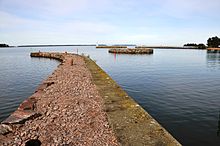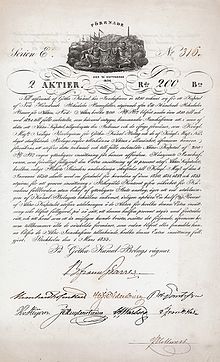Göta Canal
| Göta Canal | |
|---|---|
| location | Götaland , Sweden |
| length | 190.5 km (including 103.2 km lakes) |
| Built | 1810-1832 |
| Beginning | Mem - ( Baltic Sea ) |
| The End | Sjötorp - ( Vänern ) |
| Descent structures | 58 |
| Ports | 20th |
| Used river | Asplången, Roxen , Boren, Vättern , Viken (lakes) |
| Outstanding structures | 58 locks, 50 bridges,
two trough bridges |
| Information center, museum | FROM GÖTAKANALBOGET, Box 3, SE-591 21 Motala, [email protected], www.gotakanal.se |
| Downhill | Viken in both directions
Baltic Sea 0 m - Viken 91.8 m, Viken 91.8 m - Vänern 43.8 m (m above sea level) |
| Course of the Göta Canal (dark blue, including Göta älv and Trollhätte Canal ). | |
The Göta Canal (in Swedish Göta kanal ) is a waterway through the Swedish part of Götaland .
The canal is 190.5 km long, of which the 87.3 km actual canal stretch between the five connected lakes was dug by 58,000 Swedish soldiers. Together with the Trollhätte Canal and the Göta älv , the Göta Canal forms a 390 km long waterway across Sweden that overcomes a height difference of 91.5 m.
passage

The canal passes 58 locks , 50 bridges, two trough bridges and five lakes and can be used by ships up to 30 m long, 7 m wide, 22 m high above the water and 2.82 m draft. The Asplången , Roxen , Boren , Vättern and Viken are integrated in its course .
history
The Göta Canal Company under the direction of Baltzar von Platen received permission to build the canal on April 11, 1810, after which construction began on May 24, which lasted until 1832. It was thought that ships on the way from the Kattegat to the Baltic Sea could travel through Sweden instead of through the Øresund . In this way, the ships saved the sound tariff to Denmark . The canal opened on September 26, 1832, just two and a half decades before the railroad was introduced (1856) and the sound tariff was abolished (1857). As a result, it did not acquire any decisive economic importance, but in the event of war it was intended to be of strategic importance.
Today it is a tourist attraction. It is open from May 1st to September 27th.
The Göta Canal was included in the List of International Historic Civil Engineering Landmarks by the American Society of Civil Engineers in 1998.
traffic
Leisure boats and canal boats operate on the canal. The most famous canal ships include Juno , Diana and Wilhelm Tham . The Juno was put into service in 1874, making it one of the oldest passenger ships in service in the world. The motor freighter Sydfart is five years younger . Its dimensions were also dimensioned so that cargo travel on the Göta Canal is possible, although it was also used at sea. Like the Juno , the Sydfart is still in service in Sweden today.
Nowadays, the canal could no longer be used economically to transport goods. While a trip from Gothenburg to Stockholm on the motorway takes a few hours, the canal trip takes at least around 4 days and requires considerably more staff.
Maximum ship dimensions
The Göta Canal was built for ships up to 30 meters in length. All locks have the same dimensions, so that a ship with the maximum dimensions (especially the passenger ships that operate on the canal) just fits into all lock chambers.
| Maximum length | 30 m |
| Maximum width | 7 m |
| Maximum draft | 2.82 m |
| Maximum mast height | 22 m |
| Speed limit | 5 knots |
Locks
|
|
|
|
|
Marinas
In addition to the moorings and berths for the passenger ships, there are also a number of marinas.
| Sjötorp Vänern |
Sjötorp shipyard basin |
Sjötorp lock |
Lyrestad | Norrkvarn | Hajstorp | Törebode | Jonsboda | Vassbacken | Tåtorp | Forsvik |
|---|---|---|---|---|---|---|---|---|---|---|
| 50 | 20th | 10 | 15th | 20th | 22nd | 30th | 12 | 25th | 8th | 12 |
| Karlsborg | Motala | Motala Verkstad | Borensberg | Ljungsbro / Malfors |
Mountain marina |
Mount Roxen |
Norsholm | Söderköping / Klevbrinken |
Söderköping | Mem |
| 15th | 65 | 5 | 15th | 20th | 40 | 10 | 20th | 12 + 10 | 50 | 35 |
literature
- Ralf Schröder: Göta Canal. Through Sweden by ship. Vision Travel, Karlsruhe 2005, ISBN 3-936911-07-X .
- Experience the Göta Canal: ports & locks. Göta Canal, Vättern, Vänern, Trollhätte Canal, Delius Klasing, Hamburg 2004, ISBN 3-88412-397-1 .
- Rolf Gruel; Jürgen Schödler (Ed.): Götakanal with Göteborg, Kalmar and Karlskrona , maritime travel guide, Koehler, Hamburg 1998, ISBN 3-7822-0726-2 .
- Lutz Mohr : Baltzar Bogislaw von Platen - naval officer and builder. A native of Rügan in the Royal Swedish Military and State Services. In: The Pommersche Zeitung . Volume 64, episode 41, October 11, 2014.
The canal and the excursion boats there became famous through the detective novel Die Tote im Göta Canal by Maj Sjöwall and Per Wahlöö .
Web links
- AB Göta kanalbolag (black) - operating company of the Göta Canal
- The history of the Göta Canal
- Overview map of the canal
Footnotes
- ↑ 30 * 7 * 2.82 = 592.2t as the theoretical upper limit for the displacement
- ↑ Franz Xaver Ritter von Rudtorffer: Military Geography of Europe. Haase, Prague 1839, p. 231.
- ↑ [1] Skipper's Guide to the Göta Canal




